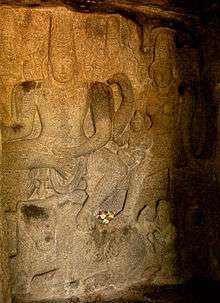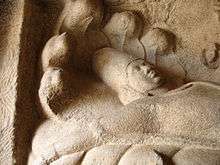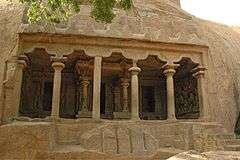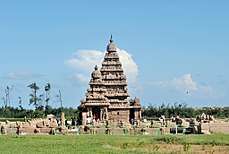Mahishasuramardini Mandapa
| Mahishasuramardini Mandapa Mahishasuramardini Cave Temple | |
|---|---|
|
Mahishamardini Rock Cut Mandapam | |
 Mahishasuramardini Mandapa Mahishasuramardini Cave Temple Location of | |
| Geography | |
| Coordinates | 12°37′00″N 80°11′30″E / 12.6167°N 80.1917°ECoordinates: 12°37′00″N 80°11′30″E / 12.6167°N 80.1917°E |
| Country | India |
| State | Tamil Nadu |
| District | Kancheepuram district |
| Culture | |
| Primary deity | Goddess Durga |
| Architecture | |
| Number of temples | 1 |
| Inscriptions | Inscribed in 1984 under Asia-Pacific of UNESCO |
| History and governance | |
| Date built | Mid-7th century |
| Creator | Pallava dynasty |
Mahishasuramardhini Mandapa (Cave Temple; also known as Yampuri)[1] is an example of Indian rock-cut architecture dating from the late 7th century, of the Pallava dynasty. It is a rock-cut cave temple located on a hill, near a lighthouse, along with other caves in Mamallapuram. It is the one of the finest testimonials of ancient Vishwakarma Sthapathis (Vishwakarma sculpture). Mamallapuram, also popularly known as Mahabalipuram, is a small village to the south of Chennai, in the state of Tamil Nadu, India.[2] The temple is part of the Group of Monuments at Mahabalipuram, a UNESCO World Heritage Site inscribed in 1984.[3] This Cave Temple has many interesting architectural features of which three exquisitely carved reliefs on the cave walls of three sanctums are prominent. One is of Vishnu reclining on the seven hooded serpent, Adisesha, another of Durga, the main deity of the cave temple slaying the buffalo headed demon Mahishasura, and the third sanctum also has a sculpture of Vishnu.[4][5] The cave also depicts many scenes from the Puranas (Hindu mythology stories in Sanskrit dating from the 5th century AD).
Legend
According to legend, Durga killed the demon Mahishasura, who was considered unconquerable. Hence, following his slaying, she was given the title Mahishasuramardhini (conqueror of Mahisha). The granite-carved cave temple depicts the goddess Mahishasuramardhini, considered an incarnation of the goddess Durga, and is named after her as "Mahishasuramardhini Cave Temple". The cave's interior relief depicts this battle. The goddess is shown riding a lion, her several arms holding a bow and arrow, pursuing the retreating Mahisha with his followers.[6]
History
The cave is dated to the period of king Narasimhavarman Mahamalla (630–668 AD) of the Pallava dynasty, after whom the town is also named.[7] The cave architecture is also said to be a continuation of the great religious themes that were carved in Western India. The cave reflects a transitional style of architecture in its columns mounted on seated lions and frescoes carved on the walls inside the cave which evolved during the rule of Pallava kings Mahendra Varman I and Rajasimha or Narasimhavarman I known as Mamalla. This style was continued by Mamalla's son Parameshvaravarman I.[8] Historical research has also confirmed that Mahabalipuram town came to be established only after it was named after Mamalla and the caves and rathas are all attributed to his reign during the year 650 AD.[9]
Geography
Mahishasura Mardhini Cave or Mantapa is situated on the top of a hill range along with other caves in Mahabalipuram town, on the Coromandel Coast of the Bay of Bengal of the Indian Ocean. Now in the Kanchipuram district, it is approximately 58 kilometres (36 mi) from Chennai city (previously, Madras) and about 20 miles (32 km) from Chingelpet.[10] A lighthouse is located beside it. A structural temple of the 8th century called the Olakkannesvara Temple (mistakenly called a Mahishasura temple) is situated near this cave at a vantage location which provides scenic views of Mamallapuram. The area is a high security zone as there is a nuclear power station a few kilometers to the south; hence, photography is prohibited.[11]
Layout
The cave shrine faces east and has three chambers. Its internal dimensions are 32 feet (9.8 m) in length, 15 feet (4.6 m) in width, and 12.5 feet (3.8 m) in height. There is frontal projection of the main central chamber when compared to the two chambers which flank it. In the front façade of the cave are 10 horseshoe-shaped windows which are kudus on the cornice; these are unfinished carvings. The cornice also depicts carvings of five gable-roofed semi-complete shrines. The façade has four carved pillars and two pilasters at the ends, which are part of the façade and are carved in the traditional Pallava architectural style. The central chamber is fronted by a small mukhamandapa (entrance porch), which has two carved pillars with lion bases in the Pallava style.[12]
Architecture


The mandapa is one of the most important caves in Mahabalipuram. It is dedicated to the goddess Mahishasuramardini, who is considered an incarnation of the goddess Durga. The mandapa is carved into the granite rock face of a hill. The verandah cut at the cave entrance, long and calumniated, has a composition of three chambers;[7] the central chamber entrance depicts guardians (dwarapalas) on the flanks. The back wall of the central chamber features a carving of a Somaskanda panel; this panel is carved with images of Shiva and his consort Parvathi in their regal dress, each wearing a crown known as kirita-mukuta and other ornamentation, with their son Skanda seated between them. This panel also shows the carving of Nandi (bull), Shiva's mount (Vahana). Chandesa, an ardent devotee of Shiva, is carved to the left of the carved images of the trinity gods Shiva, Brahma, and Vishnu, who are shown standing behind the main image of Shiva and Parvathi. The carving of the trinity gods gives the impression that they are pleased with the seated couple of Shiva, his consort and their son. In the individual depiction, Brahma is carved with four heads and four hands, with the upper hands holding a water vessel and akshamala; the lower right hand is shown raised in an appreciative gesture to Shiva, while the left hand is in a kataka mudra. Vishnu's carving is also depicted with four hands; chakra and shankha are held in his upper hands, with the lower left hand showing a gesture of appreciation to Shiva, and the lower right hand held up in a kataka mudra. The image of Surya (Sun) is carved on the top part of the panel, between Brahma and Vishnu. A separate Brahma panel carving appears on the back wall of the left chamber, while the right chamber is repeated with a panel of Shiva that, according to the opinion of archaeologists, was originally meant to host a panel of Vishnu. Another interpretation mooted for the dominance of Shiva panels in this cave is that the religious leaning of the Kings who ruled at that time changed from Vaishnavism to Shavisim.[12] Additionally, the Somaskanda panel in this cave is of a different architectural composition than similar panels carved in Dharmaraja Ratha, the Shore Temple, and the Atiranachanda Cave. Archeologists suggest the panel here was created during the reign of Rajasimha.[12]
The north wall in the cave contains a relief depicting the battle scene of the two adversaries, goddess Durga and the demon buffalo-headed Mahishasura. This panel symbolizes the triumph of good over evil. The carving is considered one of the best creations of the Pallava period. In the war scene, Durga appears with eight hands riding a fierce-looking lion. She is holding a khadga (sword), dhanush (bow), bana (arrows), ghanta (bell) in her four right hands; her four left hands display pasa, sankha, and dagger. An attendant holds a chatra (parasol) over Durga's head. She is in the battlefield with her army of female warriors and ganas (dwarfs). She is shown attacking, with arrows, the demon Mahisha, causing him to retreat with his followers. Mahishasura is armed with a gada (club).[6][12]
On the southern face of the cave, there is a panel of Vishnu in an Anantasayana mudra, a reclining posture, lying on the bed of a serpent. He is shown with two hands holding the coil of the five-headed serpent known as Adisesha, which forms a cover over Vishbu's head. Madhu and Kaitabha, the two demons, are carved near Vishnu's feet in an attacking mode, armed with a gada (mace). The demons are in a position of retreat, as Adisesha hisses at them with flames emerging from its hoods. Vishnu, unconcerned, is patting Adisesha to pacify him. Also shown in the panel are the two ganas (dwarfs). Dwarfs are Vishnu's ayudhapurushas (as his personified weapons); the male gana is known as shankha or Panchajanya, and the female gana is Vishnu's gada Kaumodaki. Also seen in the panel, at its lower end, are three figures; his chakra (discus) is Sudarshana in ayudha-purusha form, Nandaka on the right is his khadga (sword), and the female figure is Bhudevi, also as ayudha-purusha.[12]
References
| Wikimedia Commons has media related to Mahishasuramardini Cave Temple. |
- ↑ Madras literary society (1881). J.C. Morris, ed. The Journal (afterw.) The Madras journal of literature and science (Public domain ed.). p. 98. Retrieved 18 March 2013.
- ↑ "General view of the entrance to the Varaha Cave Temple, Mamallapuram". British Library. Retrieved 2008-11-18.
- ↑ "Group of Monuments at Mahabalipuram". World Heritage. Retrieved 2007-02-08.
- ↑ Shobhna Gupta (2003). Monuments Of India. Har-Anand Publications. pp. 35–. ISBN 978-81-241-0926-7. Retrieved 7 February 2013.
- ↑ Rina Kamath (1 September 2000). Chennai. Orient Blackswan. pp. 124–. ISBN 978-81-250-1378-5. Retrieved 7 February 2013.
- 1 2 Karen Schreitmüller; Mohan Dhamotharan; Beate Szerelmy (14 February 2012). Baedeker India. Baedeker. pp. 589–. ISBN 978-3-8297-6622-7. Retrieved 7 February 2013.
- 1 2 "General view of the façade of the Yamapuri or Mahishasuramardhini Cave Temple, Mamallapuram". Online Gallery of British Library. Retrieved 23 October 2012.
- ↑ G. Jouveau-Dubreuil (1 December 1994). Pallava Antiquities – 2 Vols. Asian Educational Services. pp. 30–. ISBN 978-81-206-0571-8. Retrieved 3 January 2013.
- ↑ Trudy Ring; Robert M. Salkin; Sharon La Boda (1995). Asia and Oceania: International Dictionary of Historic Places. Taylor & Francis. pp. 912–. ISBN 978-1-884964-04-6. Retrieved 7 February 2013.
- ↑ Ayyar, P. V. Jagadisa (1982). South Indian Shrines: Illustrated. Asian Educational Services. pp. 157–. ISBN 978-81-206-0151-2. Retrieved 7 February 2013.
- ↑ "Arjuna's Penance". Lonely Planet. Retrieved 30 December 2012.
- 1 2 3 4 5 "Mahabalipuram – The Workshop of Pallavas – Part II". Mahishasurmardini Cave Temple. puratattva.in. Retrieved 23 February 2013.

